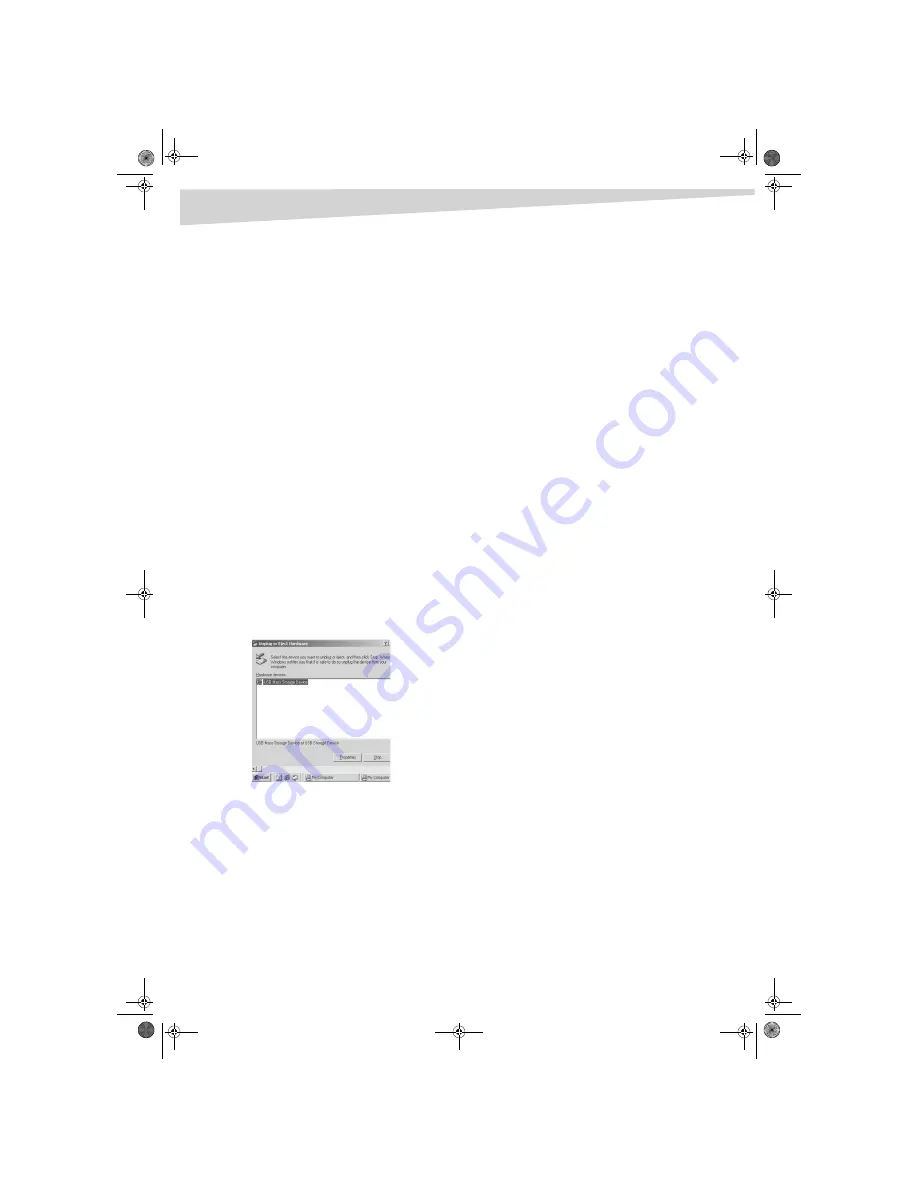
4
Legal notices
Important:
If FDISK quits without any message, click the X to go
back to the Windows 98 screen. Unplug the USB hard drive, restart
the computer, plug in the USB hard drive, then repeat this process
starting with step 3.
5
In the first screen of FDISK, answer the question:
Do you want to enable large disk support?
[Y] if you want to build a partition larger than 2 GB.
[N] if you want to build a partition smaller than 2 GB.
6
In the FDSIK OPTIONS screen, type
5
to select the drive.
Important:
You must type
5
in this screen to change the current
fixed drive to build a partition. The default fixed drive set by FDISK
is your internal hard drive. If you don’t change the fixed drive to
the USB hard drive, the data of your internal hard drive will be
destroyed.
7
In
Change Current Fixed Disk Drive
, type the drive number
that is assigned to the USB hard drive.
You are returned to the FDISK OPTITIONS screen. You can create or
delete the partition of the USB hard drive.
8
After you finish FDISK, return to the Windows screen.
9
Unplug the USB hard drive, then plug it in again to activate these
changes.
10
Double-click on the
My Computer
icon. The USB hard drive that
you partitioned appears.
Disconnecting the drive from your
computer
CAUTION:
Do not unplug the USB hard drive from your computer while
copying files to or from the hard drive or while files or applications stored
on the USB hard drive are in use.
Doing so may result in loss of data.
W
INDOWS
XP, W
INDOWS
ME,
AND
W
INDOWS
2000
To disconnect the USB hard drive in Windows XP, Windows ME, and
Windows 2000:
1
Double-click on the remove hardware icon in the system tray. The
Unplug or Eject Hardware
dialog box opens.
2
Click
USB Mass Storage Device
, then click
Stop.
3
Click the USB device that you want to disconnect, then click
Stop
.
4
Wait for few seconds. The computer prompts
You may safely
remove this device
.
5
Disconnect the USB cable from the computer’s USB port.
W
INDOWS
98SE
To disconnect the USB hard drive in Windows 98SE:
• Remove the USB cable from the computer’s USB port.
M
ACINTOSH
To disconnect the USB hard drive in Mac OS:
1
Close all windows and quit all running applications stored on the
USB drive.
2
Drag the USB hard drive’s icon into the trash can.
3
Disconnect the USB cable from the computer’s USB port.
Legal notices
FCC compliance statements
This equipment has been tested and found to comply with the limits for
a class B digital device, pursuant to part 15 of the FCC Rules. These limits
are designed to provide reasonable protection against harmful
interference in a residential installation. This equipment generates, uses
and can radiate radio frequency energy and, if not installed and used in
accordance with the instructions, there is no guarantee that interference
will not occur in a particular installation. if this equipment does cause
harmful interference to equipment off add on, the user is encouraged to
try to correct the interference by one or more of the following measures:
• Reorient or relocate the receiving antenna.
• Increase the distance between the equipment and receiver.
• Connect the equipment into an outlet on a circuit different form
that to which the receiver is connected.
• Consult the dealer or an experienced radio/TV technician for help.
Trademarks
MS-DOS, Windows, Windows 98SE, Windows 2000, Windows ME, and
Windows XP are trademarks of Microsoft Corporation.
Macintosh and Mac are trademarks of Apple computer.
All third-party brands and names are the property of their respective
owners.
Copyright
© 2005 Dynex. DYNEX and the DYNEX logo are trademarks of Best Buy
Enterprise Services, Inc. Other brands and product names are trademarks
or registered trademarks of their respective holders. Specifications and
features are subject to change without notice or obligation.
DX-HDEN20-combo.fm Page 4 Monday, July 11, 2005 5:18 PM












